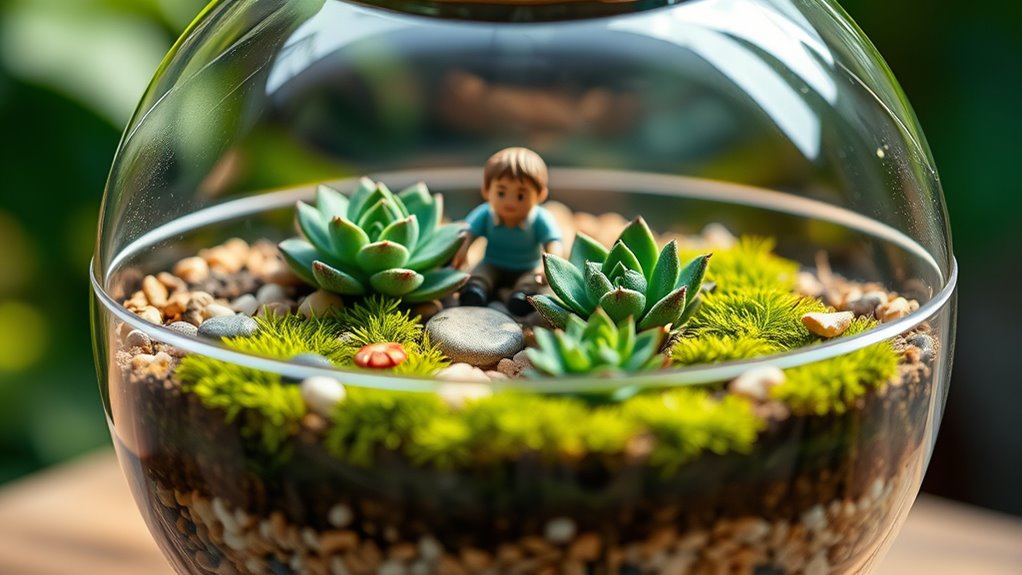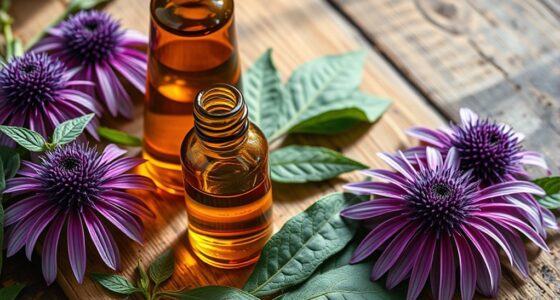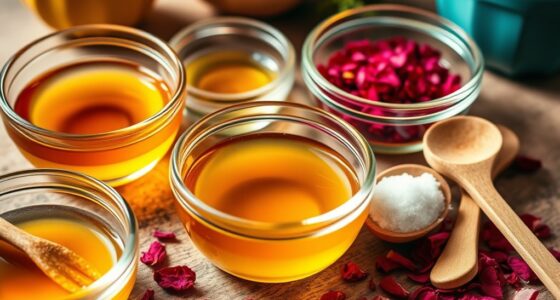To make your own terrarium, start by choosing a clear container like a glass jar or aquarium, ensuring it’s large enough for your plants and easy to access. Add a drainage layer with small rocks or charcoal, then fill with a soil mixture suited for your plants. Arrange your greenery creatively, considering height and color, and decorate with small stones or moss. For tips on maintaining and troubleshooting your mini garden, explore the full guide.
Key Takeaways
- Select a clear, non-porous container with proper drainage options.
- Create a drainage layer with small rocks, gravel, or charcoal to prevent waterlogging.
- Add a soil mixture suited for your plants, layering it over the drainage base.
- Arrange plants with similar light and water needs, placing taller ones at the back or center.
- Decorate with small stones, moss, or accessories, and maintain proper watering and airflow.
Gathering Your Materials and Choosing a Container
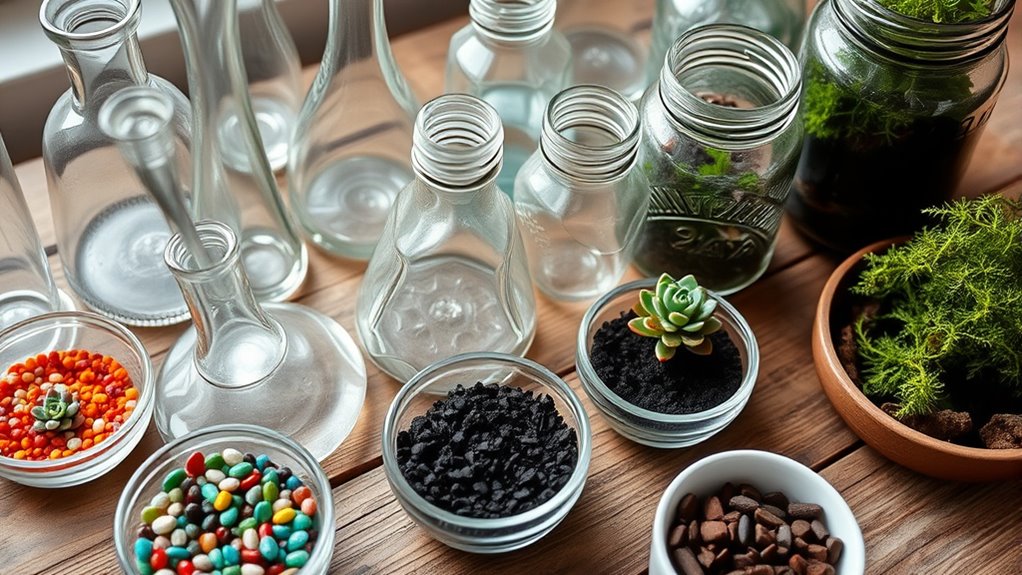
Before you begin building your terrarium, you’ll need to gather the right materials and select an appropriate container. Start by exploring container options like glass jars, aquariums, or even repurposed containers such as vases and jars. The key is choosing a clear, non-porous material that allows light to reach your plants and makes viewing easy. When considering material selection, prioritize durability and ease of cleaning. Glass is a popular choice because it’s transparent and stylish, but plastic containers can work too if they’re sturdy and safe for plants. Verify your container has an opening wide enough for planting and maintenance. Picking the right container sets a strong foundation for your terrarium and ensures you’ll enjoy it for years to come. Incorporating natural materials such as wood or stone into your container can enhance the aesthetic and create a more authentic environment.
Preparing the Base Layer for Drainage
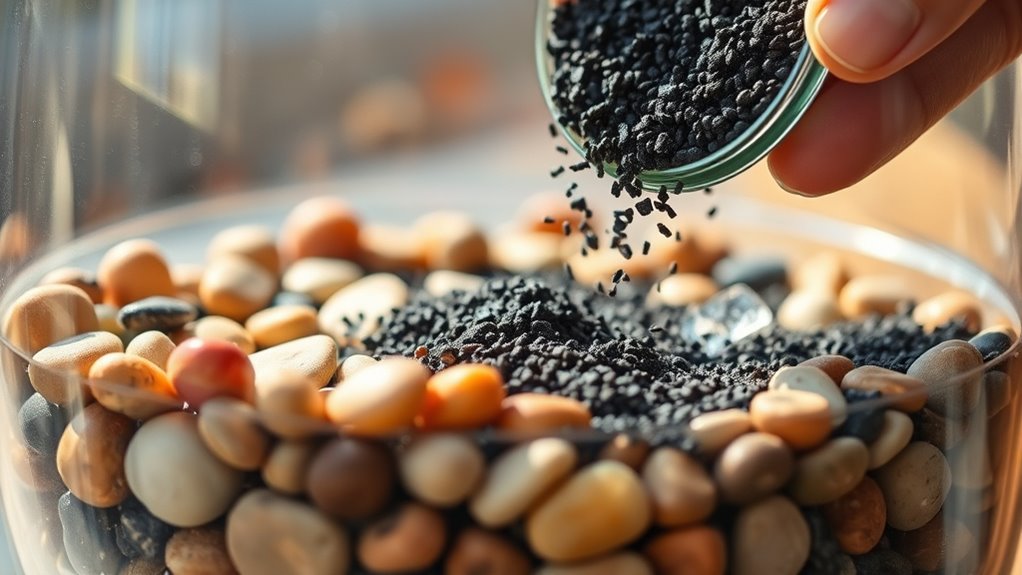
To guarantee your terrarium doesn’t become waterlogged, start by creating a proper drainage layer at the bottom of your container. This layer prevents excess water from sitting in the soil and causing root rot. Use small rocks, gravel, or charcoal to form this base, ensuring good airflow and moisture control. The soil mixture you add later should be designed to retain some moisture without becoming soggy, so avoid overly dense or water-retentive materials. By establishing a solid drainage layer, you give your plants the right environment to thrive, reducing the risk of overwatering. This step is essential for a healthy, long-lasting terrarium that stays vibrant and balanced. Once the drainage layer is in place, you’re ready for the next phase of planting.
Adding the Soil and Planting Your Greenery
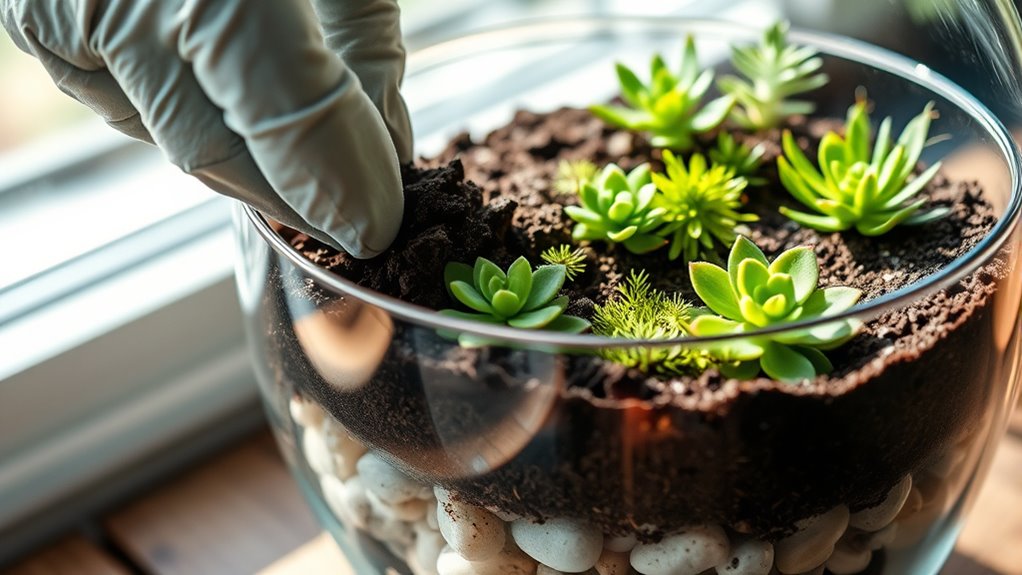
Now, it’s time to add the soil and plant your greenery. Make sure you choose the right soil that supports your plants and layer it properly for good drainage. As you plant, consider how to arrange your greenery to create a balanced and attractive terrarium. For optimal results, select best soil types suitable for your specific plants to ensure healthy growth.
Choosing the Right Soil
Have you chosen the right soil for your terrarium? The ideal soil provides essential nutrients and supports healthy plant growth. Look for a mix that balances soil nutrients and drains well, such as a blend of potting soil, sand, and organic matter. Before using, soil sterilization is vital to eliminate pests, mold, or bacteria that could harm your plants. You can sterilize soil by baking it in the oven at 180°F (82°C) for about 30 minutes. This process ensures a clean environment for your greenery. Avoid using garden soil directly, as it may contain unwanted pests or diseases. Selecting the right soil is key to creating a thriving, long-lasting terrarium. Proper preparation sets the foundation for a lush, healthy miniature ecosystem. Understanding soil properties is essential for choosing the best mix for your plants.
Layering Techniques for Drainage
Start by creating a well-draining base with a layer of small stones, gravel, or activated charcoal to prevent water from stagnating around your roots. This layer promotes air circulation and helps control excess moisture, which is essential for healthy plant growth. Confirm the layer is even, providing a stable foundation for the soil above. Next, add your soil mixture on top, filling the container about two-thirds full. The soil should be loose to encourage roots to breathe and grow freely. Proper layering ensures water drains efficiently, reducing the risk of overwatering and root rot. By carefully controlling moisture levels and promoting good air circulation with this drainage technique, your terrarium environment stays balanced and healthy for your greenery to thrive. Additionally, understanding the importance of drainage can help you create a more resilient and thriving miniature garden.
Planting and Arrangement
How do you guarantee your plants are properly anchored and arranged for a visually appealing terrarium? First, gently remove your plants from their containers, loosening their roots if needed. Position taller plants toward the back or center, and shorter ones in front to create depth. Carefully add soil around the roots, ensuring they stay upright and secure. To promote air circulation, avoid overpacking soil, which can suffocate roots. Consider sunlight exposure when placing each plant; some thrive in bright light, while others prefer indirect or low light. Gently press the soil to eliminate air pockets, but don’t compact it too tightly. Proper arrangement and planting help your terrarium stay healthy, balanced, and visually appealing. Incorporating visualization techniques can also help in designing a harmonious layout that is both attractive and functional.
Arranging and Styling Your Terrarium
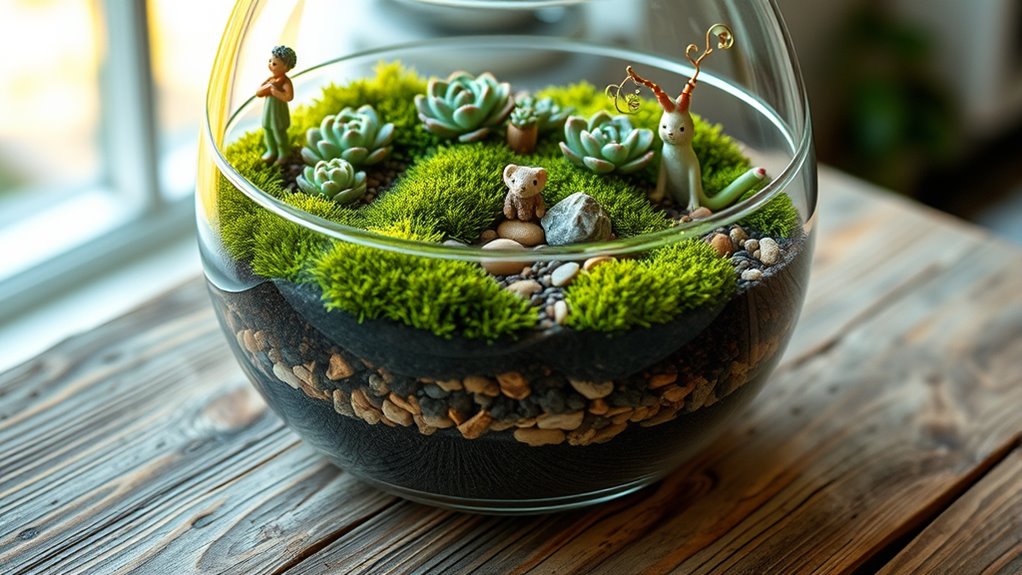
Now that your plants are in place, it’s time to arrange and style your terrarium. Use layering techniques to add depth, select plants that complement each other, and thoughtfully place decorative elements for visual appeal. With these steps, your terrarium will look both beautiful and balanced. Incorporating design principles can help create a more cohesive and visually pleasing arrangement.
Layering Techniques for Depth
To create a sense of depth and visual interest in your terrarium, careful layering is essential. Start by placing a base layer of gravel or small stones to ensure proper drainage. Next, add activated charcoal to help filter odors and keep your environment fresh. Then, layer soil, choosing different shades or textures to introduce color contrast, which enhances visual depth. When arranging plants, place taller or more prominent ones towards the back or center, and smaller plants in the foreground. Varying the heights and colors of your plants creates a layered effect that draws the eye inward. Use decorative elements sparingly to avoid clutter, emphasizing the depth produced by your layered materials. This technique makes your terrarium look more dynamic and engaging. Additionally, incorporating automation in your care routine can help monitor moisture levels and maintain optimal conditions for your plants.
Choosing Complementary Plants
Choosing the right plants is key to creating a harmonious and visually appealing terrarium. Focus on plant pairing that balances size, texture, and growth habits to prevent overcrowding. Combine plants with similar light and moisture needs to make sure they thrive together. When considering color coordination, select plants with contrasting hues or complementary shades to add visual interest. For example, pairing lush green foliage with vibrant succulents or colorful moss can create striking contrasts. Think about the overall style you want—whether lush and jungle-like or minimalist—and choose plants that fit that vision. Keep in mind that some plants grow faster than others, so plan for future growth when arranging your plant selection, making certain your terrarium remains balanced over time. Additionally, understanding each plant’s specific water requirements will help you maintain a healthy environment within your terrarium.
Decorative Elements Placement
Decorative elements are the finishing touches that bring your terrarium to life and reflect your personal style. To achieve a balanced look, carefully place ornamental accents and decorative fillers throughout your arrangement. Use decorative fillers like small stones, moss, or sand to create layers and textures, enhancing visual interest. Position ornamental accents such as tiny figurines, seashells, or miniature furniture to highlight focal points. Distribute these elements evenly, avoiding clutter, so they complement your plants without overwhelming them. Consider the scale and color of each piece, ensuring harmony within the space. Remember, the goal is to create a cohesive, attractive scene that showcases your creativity while maintaining functionality. Thoughtful placement of decorative elements elevates your terrarium from simple greenery to a stunning miniature landscape. Additionally, incorporating design principles can help ensure your arrangement remains visually appealing and well-balanced.
Caring for Your Miniature Garden
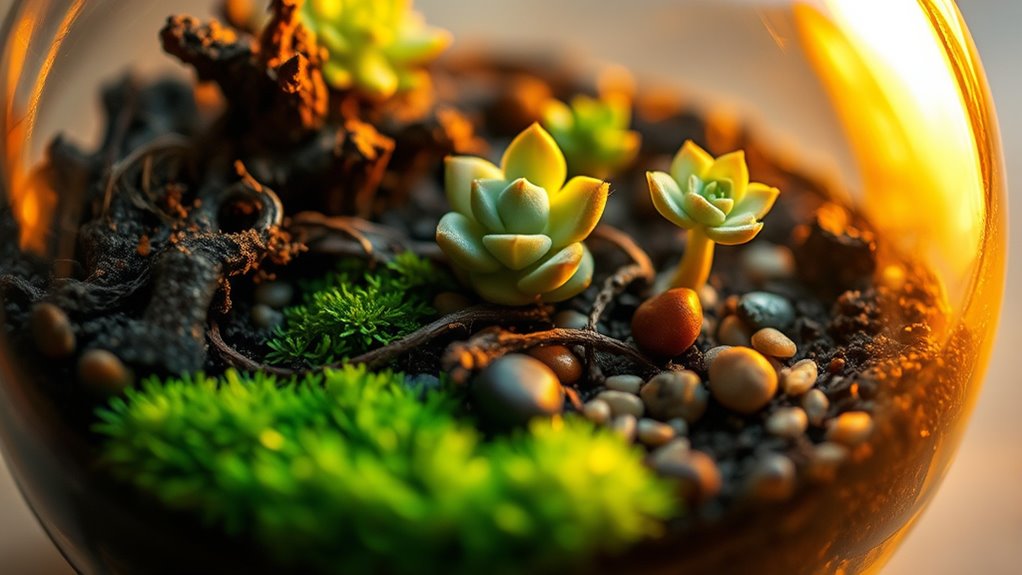
Caring for your miniature garden involves regular attention to make sure it stays healthy and vibrant. Establishing consistent watering schedules is essential; check your plants daily and water only when the soil feels dry. Overwatering can lead to root rot, so ensure excess water drains properly. Pest prevention is equally important—inspect your plants regularly for pests like aphids or spider mites, and remove any unwanted visitors promptly. Keep the terrarium clean by trimming dead or yellowing leaves and wiping down glass surfaces to maintain clear visibility. Proper airflow helps reduce mold growth, so avoid overcrowding plants. Additionally, understanding color accuracy and how it impacts the display can help you select plants with vibrant hues that thrive under your terrarium lighting. With attentive watering and vigilant pest prevention, your miniature garden will thrive and continue to bring beauty to your space.
Troubleshooting Common Issues
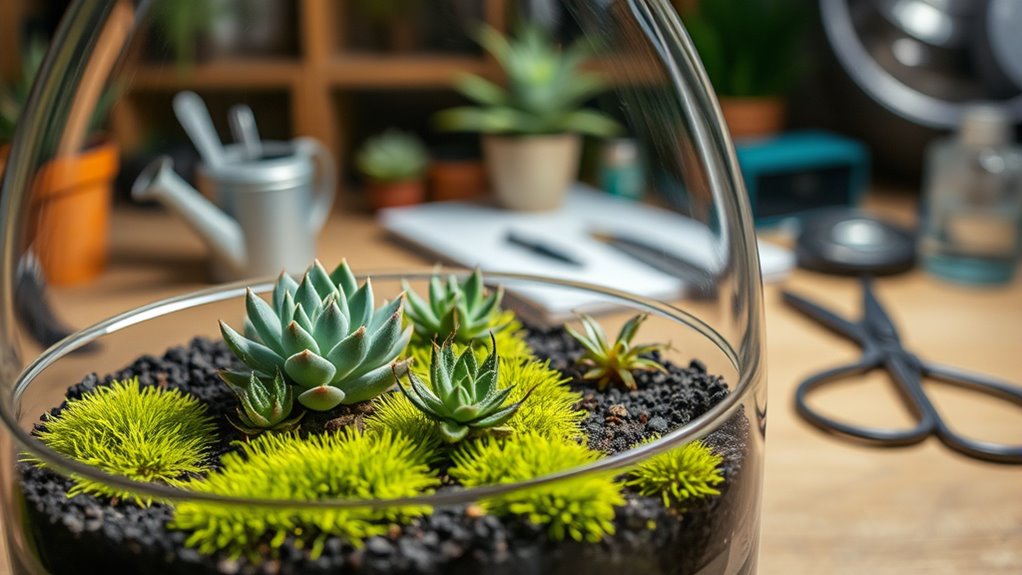
Even with careful maintenance, your terrarium may encounter common issues like mold, yellowing leaves, or stunted growth. To troubleshoot, start by checking watering issues: overwatering can cause mold and root rot; underwatering leads to wilting. Next, inspect for pest control problems: tiny insects or webs indicate pests that need prompt treatment. Consider these steps:
- Remove visible mold and improve air circulation.
- Adjust watering frequency—less water if the soil stays wet.
- Isolate and treat pests with natural remedies or insecticidal soap.
- Prune yellow or dead leaves to promote healthy growth.
Frequently Asked Questions
Can I Use Artificial Plants in My Terrarium?
You can definitely use artificial plant options in your terrarium. They offer low maintenance of fake greenery, making your setup look vibrant without the need for watering or sunlight. Artificial plants are a great choice if you want a long-lasting, mess-free display. Just guarantee you choose realistic-looking options and arrange them carefully to create a natural appearance. This way, your terrarium stays beautiful with minimal effort.
What Are the Best Lighting Conditions for My Terrarium?
You should aim for bright, indirect light for your terrarium. Light intensity is key; direct sunlight can overheat or scorch your plants, so place it near a window with filtered natural sunlight. If natural light is limited, consider using grow lights that mimic sunlight to guarantee your plants thrive. Keep an eye on your terrarium’s health and adjust its position to maintain the right balance of light.
How Often Should I Water My Terrarium?
Imagine you have a lush, green terrarium thriving with vibrant plants. To keep it healthy, you need a proper watering schedule. Typically, you should water your terrarium when the topsoil feels dry—about once a week for most setups. This helps maintain the right terrarium humidity without overwatering. Adjust based on your plant types and environment, ensuring consistent moisture levels to prevent mold and promote growth.
Are There Specific Pests to Watch For?
You should watch for pests like fungus gnats, aphids, and spider mites. For pest prevention, keep your terrarium clean and avoid overwatering, which attracts pests. Natural pest control methods, like introducing beneficial insects or using neem oil, work well without chemicals. Regularly inspect your plants, and if you spot pests early, act quickly to prevent an infestation. This keeps your terrarium healthy and thriving.
Can I Create a Themed or Decorative Terrarium?
Imagine transforming your terrarium into a captivating display—yes, you can create a themed or decorative terrarium! Start with DIY themes like desert, woodland, or fairy gardens to set the mood. Add decorative accessories such as tiny figurines, colorful stones, or miniature furniture to bring your vision to life. The key is to choose elements that complement your theme, turning your terrarium into a personalized, enchanting miniature world.
Conclusion
Creating your own terrarium isn’t just about assembling plants; it’s about nurturing a tiny ecosystem that reflects your care and attention. Some say that watching a terrarium thrive proves your ability to influence nature on a small scale. While this might be true, remember that even the tiniest garden requires patience and understanding. Your effort transforms a simple container into a lively, living work of art—reminding us that growth often begins with small, mindful steps.
